AI in Life Sciences Market Size
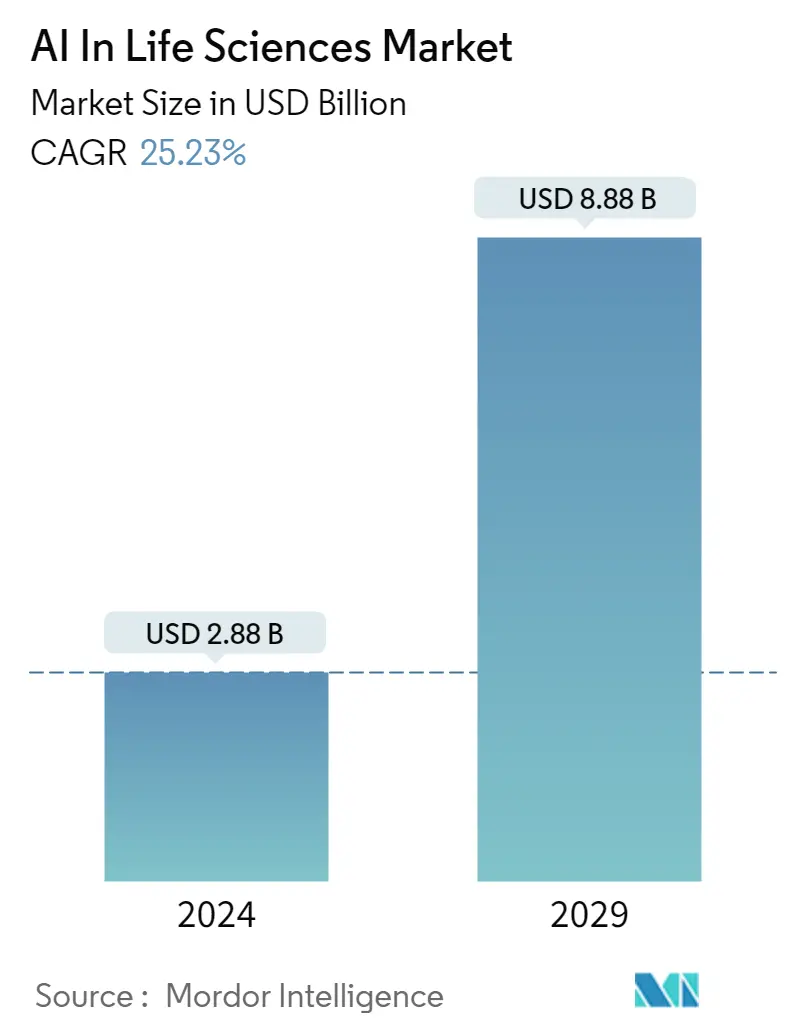
| Study Period | 2019 - 2029 |
| Market Size (2024) | USD 2.88 Billion |
| Market Size (2029) | USD 8.88 Billion |
| CAGR (2024 - 2029) | 25.23 % |
| Fastest Growing Market | Asia Pacific |
| Largest Market | North America |
Major Players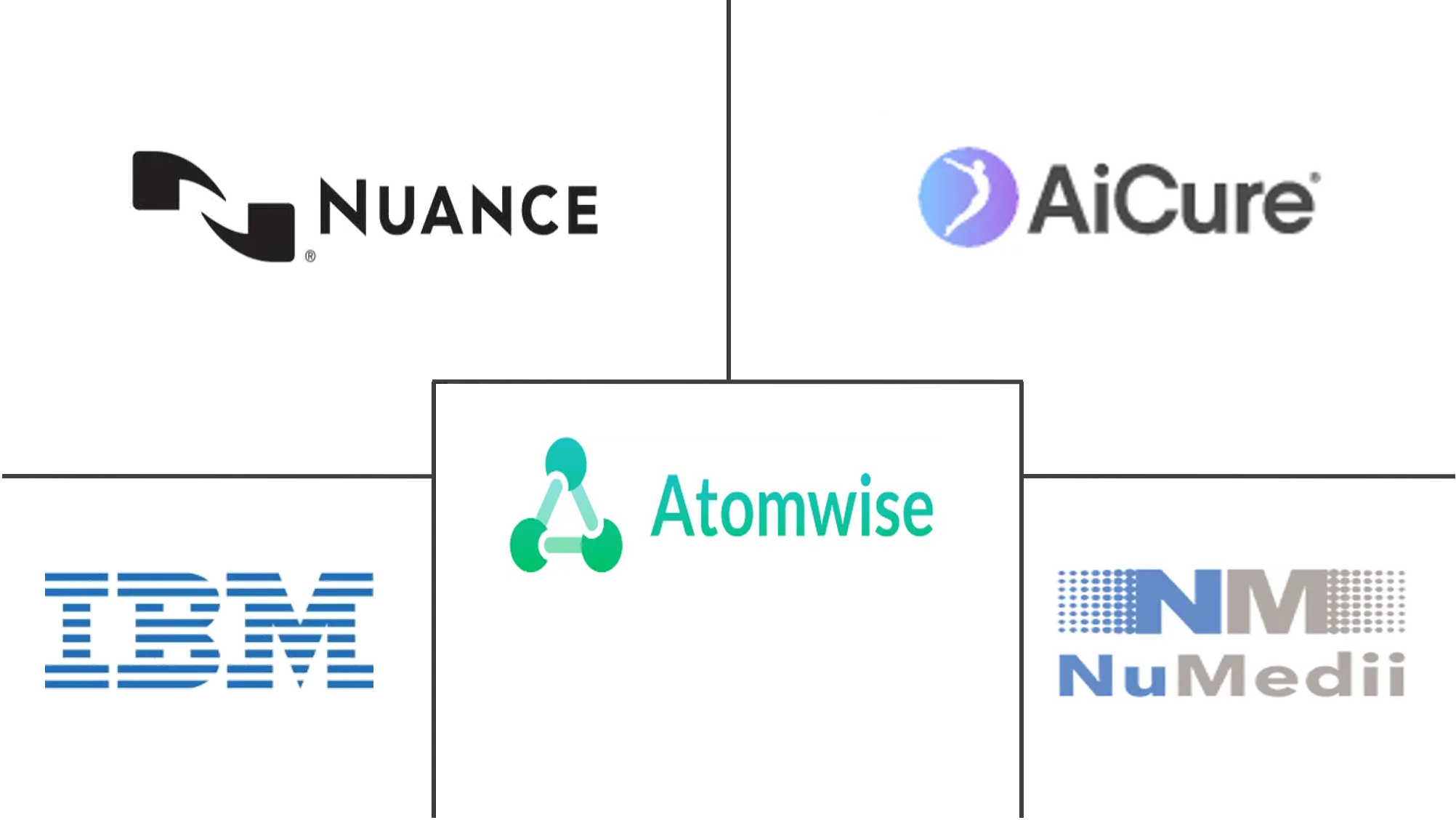
*Disclaimer: Major Players sorted in no particular order |
AI in Life Sciences Market Analysis
The AI In Life Sciences Market size is estimated at USD 2.88 billion in 2024, and is expected to reach USD 8.88 billion by 2029, growing at a CAGR of 25.23% during the forecast period (2024-2029).
The COVID-19 outbreak has made profound and lasting impacts on the health and life sciences industry. The outbreak has caused life sciences organizations to adjust to supply chain and clinical development disruptions and financial challenges that would have previously been unthinkable. In the near term, healthcare organizations will accelerate innovation to respond to the crisis. These investments would enable healthcare organizations post-COVID-19 to rethink care delivery and financing, thereby stimulating the growth in the adoption of AI for the life sciences industry.
- Further, the industry is witnessing a transformation owing to increasing cost pressure, a greater need for productivity, and disruption caused by new and innovative market players. An emerging area of artificial intelligence (AI), specifically the analysis of small systems-of-interest-specific datasets, can be utilized to improve drug development and personalized medicine.
- According to a study published in Science Translational Medicine, Quadratic Phenotypic Optimization Platform (QPOP), an AI platform, can substantially improve combination therapy in bortezomib-resistant multiple myeloma, which is used to identify the best drug combinations for individual multiple myeloma patients.
- Furthermore, complex diseases, such as cancer, often require effective drug combinations to make any significant therapeutic impact. As the drugs in these combination therapies become increasingly specific to molecular targets, designing effective drug combinations and choosing the right drug combination for the right patient becomes more difficult. With the high average development costs (around USD 2 billion for a newly approved treatment), low clinical trial drug success rate (below 12%), low return-on-investment (ROI) due to reduced healthcare expenditure, and focus on rare diseases, drug discovery is becoming more inefficient.
- Clinical trial research is extensive progress, which can be reduced with the help of AI in numerous ways. One is using advanced predictive analytics on a broad range of data to quickly identify candidates for clinical trials for target populations. Additionally, machine learning applications can make clinical trials more efficient by facilitating tasks such as calculating ideal sample sizes, facilitating patient recruitment, and using medical records to minimize data errors.
- Artificial Intelligence (AI) presents one of the most promising and potentially transformative opportunities for the life sciences industry. AI will be a key investment target in the coming years, with myriad organizations hoping to capitalize on its potential. The number of applications is expected to continue to increase, and investors are expected to enter the AI industry early.
AI in Life Sciences Market Trends
This section covers the major market trends shaping the Artificial Intelligence in Life Sciences Market according to our research experts:
Increasing Use of Artificial Intelligence in Clinical Trials is Driving the Market
- Clinical trials are one of the most data-intensive tasks in the life sciences industry. They generate vast sets of data every day, monitoring several patient variables under observation. Subjecting these data sets to intelligent AI algorithms can help researchers screen meaningful correlations between loosely coupled data.
- This encourages many pharmaceutical companies and clinical research organizations to invest in technologies like artificial intelligence. In the current market scenario, the rapid adoption of AI is widely seen in the pharmaceutical sector, which is responsible for almost 50% of the clinical trials conducted globally every year.
- Furthermore, the increasing number of clinical trials worldwide produces colossal amounts of data available in the public domain. Over the forecast period, these numbers are expected to increase by at least 11%, creating new opportunities for AI in clinical trial applications, especially in Europe and North America.
- Such rapid growth in clinical trials and public availability of data is helping and encouraging many research institutes to prefer AI over traditional software solutions so that they can obtain specific results from data available in the public domain without having the entire trial procedure. Additionally, many countries, like China, the United States, and several European countries, are making clinical trial data available in the public domain supporting the growth of AI solutions globally.
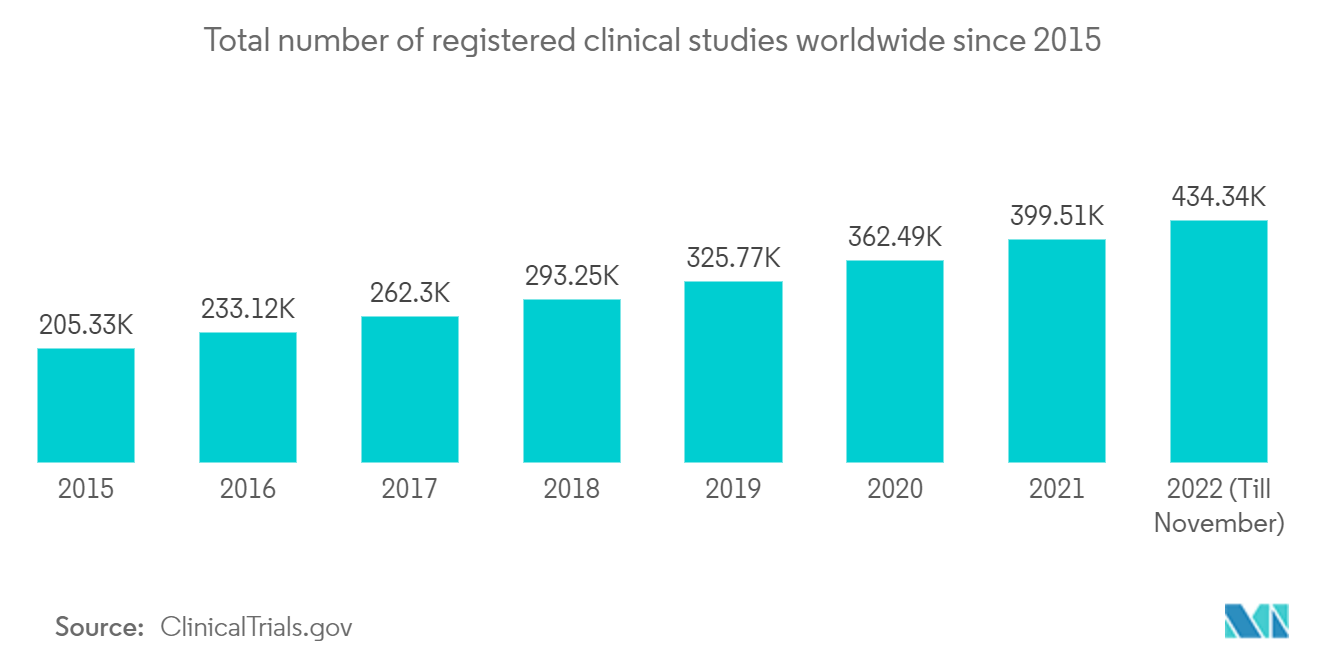
The United States is Expected to Hold a Major Share in the Market
- The United States is the largest market for A.I. solutions in the life sciences market, owing to the high demand for A.I. solutions from almost all the life sciences applications in the United States. In addition, the significant presence of pharmaceutical companies and the global demand for U.S. pharmaceutical exports are increasingly motivating companies to invest in R&D activities.
- According to the Pharmaceutical Research and Manufacturers of America (PhRMA). Moreover, according to the report of PhRMA pending of the U.S. pharmaceutical industry for research and development, the percentage of total revenues in the previous year was 21.2%.
- PhRMA also revealed that, on average, most pharmaceutical companies in the country spent over 19% of their total revenues on R&D activities. Moreover, PhRMA R&D investments will reach a record high of USD 102.3 billion in 2021.
- Many pharmaceutical companies, such as Pfizer, Johnson & Johnson, and several clinical research organizations, are increasingly spending on A.I. solutions. According to ClinicalTrials.gov, it is projected that by 2024 Johnson & Johnson will have the most significant research and development spending among pharmaceutical companies. Also, companies, like Pfizer, despite collaborating with several A.I. vendors, are investing in updating their in-house A.I. operations to support their ongoing several drug discovery and patient monitoring processes.
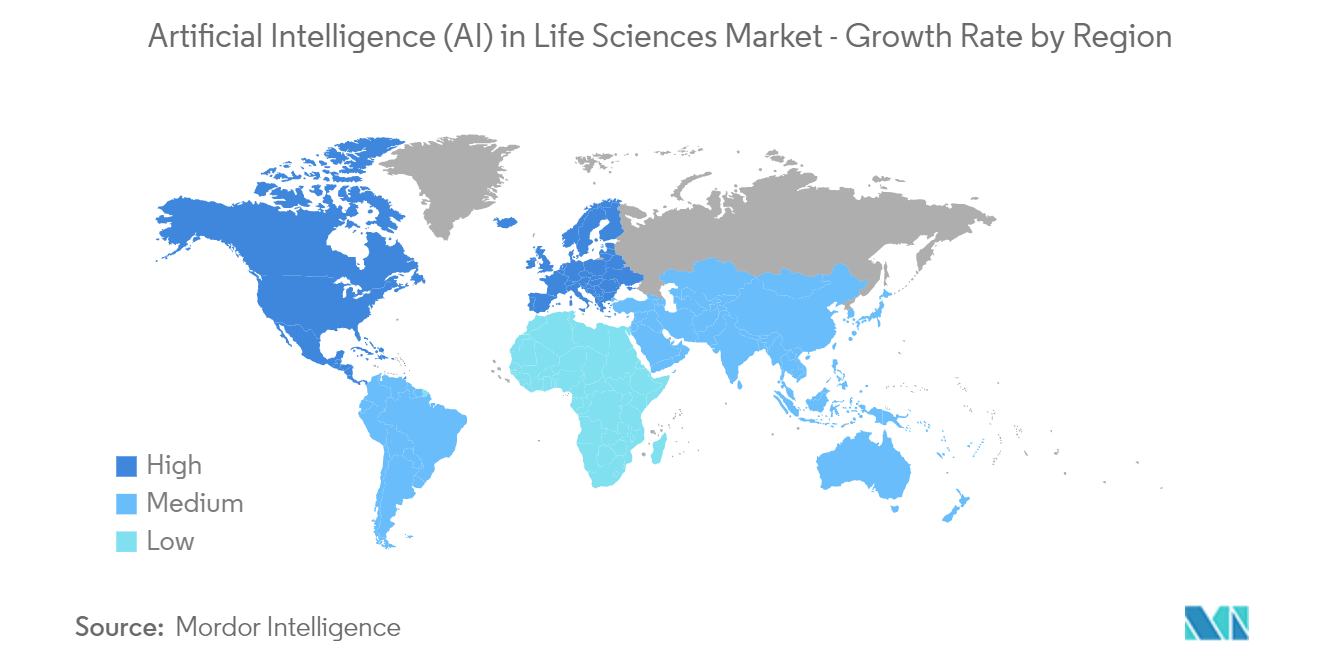
AI in Life Sciences Industry Overview
Artificial intelligence in the Life Sciences Market is highly competitive and consists of several major players. The market is moderately concentrated. The major players with prominent shares in the market are focusing on expanding their customer base across foreign countries. These companies are leveraging strategic collaborative initiatives to increase their market share and increase their profitability. The companies operating in the market are also acquiring start-ups working on artificial intelligence in life sciences technologies to strengthen their product capabilities.
In November 2022, XtalPi Inc. announced that the company is looking forward to a strategic partnership with CK Life Sciences. In order to enhance the discovery and design skills of tumor vaccines and speed up the creation of new vaccine kinds, this collaboration will take advantage of their individual expertise to establish a revolutionary AI tumor vaccine R&D platform. In June 2022, Amgen's R&D announced the partnership with The Scientist; this collaboration examines cutting-edge drug discovery and development methods that use artificial intelligence (AI) and machine learning to create brand-new protein therapies.
AI in Life Sciences Market Leaders
-
IBM Corporation
-
NuMedii Inc.
-
Atomwise Inc
-
AiCure LLC
-
Nuance Communications Inc.
*Disclaimer: Major Players sorted in no particular order
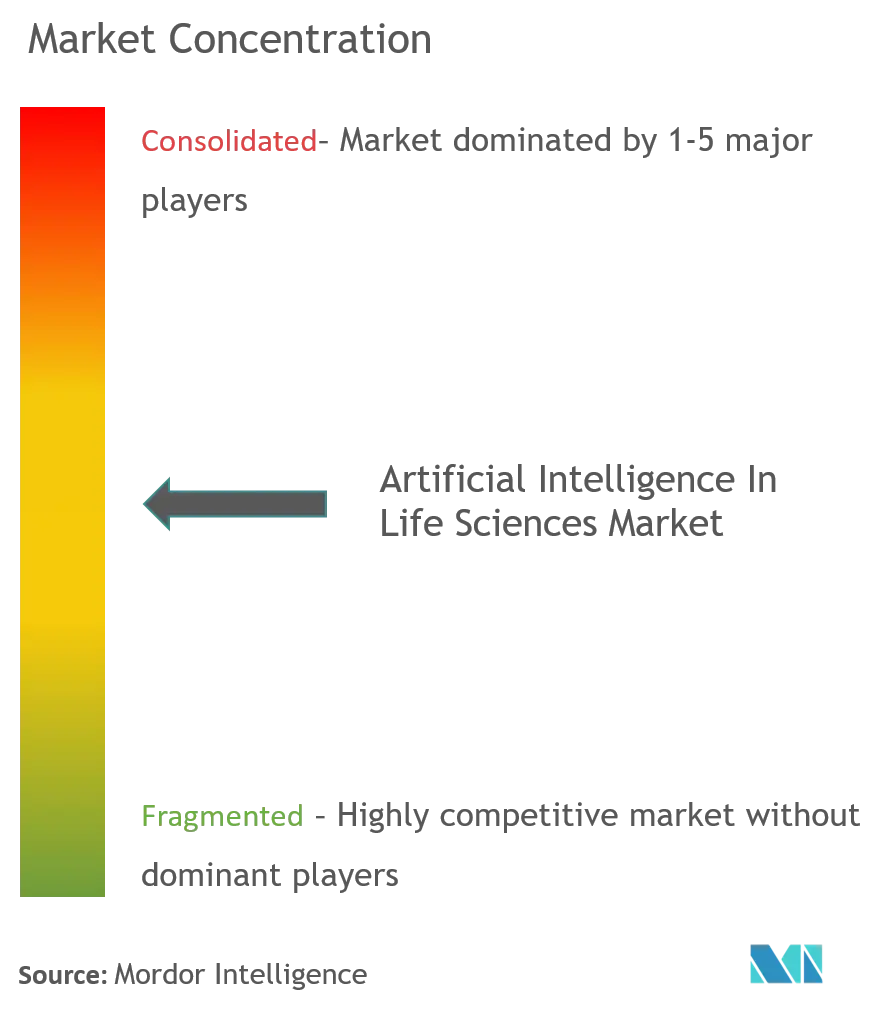
AI in Life Sciences Market News
- August 2022: Atomwise announced the strategic partnership with Sanofi to use the former's artificial intelligence (AI)-driven AtomNet platform to discover and research up to five drug targets computationally.
- June 2022: An artificial intelligence (AI)-powered ACTO, a commercial learning platform for the life sciences sector, has launched a conversational assistant called "LAICA." LAICA provides users with a voice search assistant that supports learning for Life Sciences commercial and medical affairs teams in real-time
AI in Life Sciences Market Report - Table of Contents
1. INTRODUCTION
- 1.1 Study Assumptions and Market Definition
- 1.2 Scope of the Study
2. RESEARCH METHODOLOGY
3. EXECUTIVE SUMMARY
4. MARKET DYNAMICS
- 4.1 Market Overview
-
4.2 Industry Attractiveness - Porter Five Forces
- 4.2.1 Threat of New Entrants
- 4.2.2 Bargaining Power of Buyers/Consumers
- 4.2.3 Bargaining Power of Suppliers
- 4.2.4 Threat of Substitute Products
- 4.2.5 Intensity of Competitive Rivalry
-
4.3 Market Drivers
- 4.3.1 Increasing Adoption of AI in the Domain of R&D
- 4.3.2 High Emphasis on the Development of Precision Medicine and Personalized Drugs
- 4.3.3 Increasing Demand for AI in Drug Discovery
- 4.3.4 Increasing Use of Artificial Intelligence in Clinical Trials
-
4.4 Market Restraints
- 4.4.1 High Initial Costs and Concerns over the Replacement of Human Workforce
- 4.5 Technology Snapshot
- 4.6 Impact of COVID-19 on the Industry
5. MARKET SEGMENTATION
-
5.1 Application
- 5.1.1 Drug Discovery
- 5.1.2 Medical Diagnosis
- 5.1.3 Biotechnology
- 5.1.4 Clinical Trails
- 5.1.5 Precision and Personalized Medicine
- 5.1.6 Patient Monitoring
-
5.2 Geography
- 5.2.1 North America
- 5.2.1.1 United States
- 5.2.1.2 Canada
- 5.2.2 Europe
- 5.2.2.1 Germany
- 5.2.2.2 United Kingdom
- 5.2.2.3 France
- 5.2.2.4 Rest of Europe
- 5.2.3 Asia Pacific
- 5.2.3.1 China
- 5.2.3.2 Japan
- 5.2.3.3 India
- 5.2.3.4 South Korea
- 5.2.3.5 Rest of Asia Pacific
- 5.2.4 Rest of the World
6. COMPETITIVE LANDSCAPE
-
6.1 Company Profiles*
- 6.1.1 IBM Corporation
- 6.1.2 NuMedii Inc.
- 6.1.3 Atomwise Inc
- 6.1.4 AiCure LLC
- 6.1.5 Nuance Communications Inc.
- 6.1.6 Sensely Inc.
- 6.1.7 Sophia Genetics SA
- 6.1.8 Insilico Medicine Inc.
- 6.1.9 Enlitic Inc.
- 6.1.10 Apixio Inc.
- 6.1.11 Zebra Medical Vision
- 6.1.12 twoXAR Inc.
7. INVESTMENT ANALYSIS
8. FUTURE OF THE MARKET
** Subject To AvailablityAI in Life Sciences Industry Segmentation
Artificial intelligence (AI) in the life sciences industry is used for various applications, such as drug discovery, biotechnology, medical diagnosis, clinical trials, precision and personalized medicine, and patient monitoring. The study also categorizes the impact of these applications across various regions. AI is a highly data-driven technology. In the life sciences sector, it is commonly employed to make meaningful relations from loosely coupled data. With the introduction of the third wave of AI, it is anticipated that advanced AI solutions can learn and evolve as they find novel applications. The study also assesses the impact of COVID-19 on the industry.
The Artificial Intelligence in Life Sciences Market is segmented by Application (Drug Discovery, Medical Diagnosis, Biotechnology, Clinical Trials, Precision, and Personalized Medicine, Patient Monitoring) and Geography (North America, Europe, Asia Pacific, Latin America, and Middle East and Africa).
The market sizes and forecasts are provided in terms of value (USD million) for all the above segments.
| Application | Drug Discovery | |
| Medical Diagnosis | ||
| Biotechnology | ||
| Clinical Trails | ||
| Precision and Personalized Medicine | ||
| Patient Monitoring | ||
| Geography | North America | United States |
| Canada | ||
| Geography | Europe | Germany |
| United Kingdom | ||
| France | ||
| Rest of Europe | ||
| Geography | Asia Pacific | China |
| Japan | ||
| India | ||
| South Korea | ||
| Rest of Asia Pacific | ||
| Geography | Rest of the World |
AI in Life Sciences Market Research FAQs
How big is the AI In Life Sciences Market?
The AI In Life Sciences Market size is expected to reach USD 2.88 billion in 2024 and grow at a CAGR of 25.23% to reach USD 8.88 billion by 2029.
What is the current AI In Life Sciences Market size?
In 2024, the AI In Life Sciences Market size is expected to reach USD 2.88 billion.
Who are the key players in AI In Life Sciences Market?
IBM Corporation, NuMedii Inc., Atomwise Inc, AiCure LLC and Nuance Communications Inc. are the major companies operating in the AI In Life Sciences Market.
Which is the fastest growing region in AI In Life Sciences Market?
Asia Pacific is estimated to grow at the highest CAGR over the forecast period (2024-2029).
Which region has the biggest share in AI In Life Sciences Market?
In 2024, the North America accounts for the largest market share in AI In Life Sciences Market.
What years does this AI In Life Sciences Market cover, and what was the market size in 2023?
In 2023, the AI In Life Sciences Market size was estimated at USD 2.30 billion. The report covers the AI In Life Sciences Market historical market size for years: 2019, 2020, 2021, 2022 and 2023. The report also forecasts the AI In Life Sciences Market size for years: 2024, 2025, 2026, 2027, 2028 and 2029.
AI in Life Sciences Industry Report
Statistics for the 2023 AI in Life Sciences market share, size and revenue growth rate, created by Mordor Intelligence™ Industry Reports. AI in Life Sciences analysis includes a market forecast outlook to 2029 and historical overview. Get a sample of this industry analysis as a free report PDF download.



